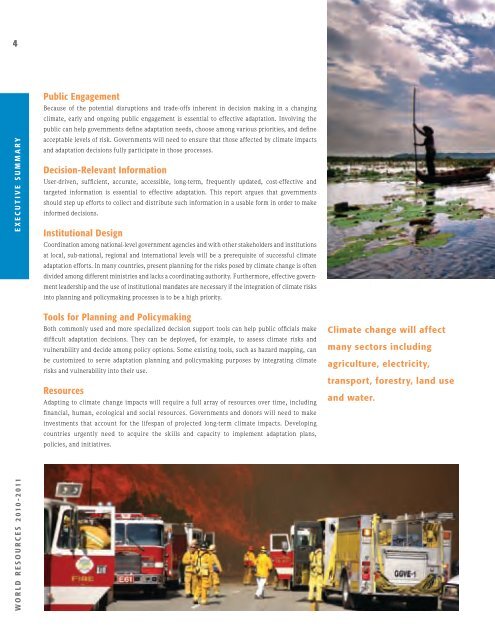Decision Making in a Changing Climate - World Resources Institute
Decision Making in a Changing Climate - World Resources Institute
Decision Making in a Changing Climate - World Resources Institute
- No tags were found...
You also want an ePaper? Increase the reach of your titles
YUMPU automatically turns print PDFs into web optimized ePapers that Google loves.
4<strong>World</strong> <strong>Resources</strong> 2010-2011 executive chapter Summary ?Public EngagementBecause of the potential disruptions and trade-offs <strong>in</strong>herent <strong>in</strong> decision mak<strong>in</strong>g <strong>in</strong> a chang<strong>in</strong>gclimate, early and ongo<strong>in</strong>g public engagement is essential to effective adaptation. Involv<strong>in</strong>g thepublic can help governments def<strong>in</strong>e adaptation needs, choose among various priorities, and def<strong>in</strong>eacceptable levels of risk. Governments will need to ensure that those affected by climate impactsand adaptation decisions fully participate <strong>in</strong> those processes.<strong>Decision</strong>-Relevant InformationUser-driven, sufficient, accurate, accessible, long-term, frequently updated, cost-effective andtargeted <strong>in</strong>formation is essential to effective adaptation. This report argues that governmentsshould step up efforts to collect and distribute such <strong>in</strong>formation <strong>in</strong> a usable form <strong>in</strong> order to make<strong>in</strong>formed decisions.Institutional DesignCoord<strong>in</strong>ation among national-level government agencies and with other stakeholders and <strong>in</strong>stitutionsat local, sub-national, regional and <strong>in</strong>ternational levels will be a prerequisite of successful climateadaptation efforts. In many countries, present plann<strong>in</strong>g for the risks posed by climate change is oftendivided among different m<strong>in</strong>istries and lacks a coord<strong>in</strong>at<strong>in</strong>g authority. Furthermore, effective governmentleadership and the use of <strong>in</strong>stitutional mandates are necessary if the <strong>in</strong>tegration of climate risks<strong>in</strong>to plann<strong>in</strong>g and policymak<strong>in</strong>g processes is to be a high priority.Tools for Plann<strong>in</strong>g and Policymak<strong>in</strong>gBoth commonly used and more specialized decision support tools can help public officials makedifficult adaptation decisions. They can be deployed, for example, to assess climate risks andvulnerability and decide among policy options. Some exist<strong>in</strong>g tools, such as hazard mapp<strong>in</strong>g, canbe customized to serve adaptation plann<strong>in</strong>g and policymak<strong>in</strong>g purposes by <strong>in</strong>tegrat<strong>in</strong>g climaterisks and vulnerability <strong>in</strong>to their use.<strong>Resources</strong>Adapt<strong>in</strong>g to climate change impacts will require a full array of resources over time, <strong>in</strong>clud<strong>in</strong>gf<strong>in</strong>ancial, human, ecological and social resources. Governments and donors will need to make<strong>in</strong>vestments that account for the lifespan of projected long-term climate impacts. Develop<strong>in</strong>gcountries urgently need to acquire the skills and capacity to implement adaptation plans,policies, and <strong>in</strong>itiatives.<strong>Climate</strong> change will affectmany sectors <strong>in</strong>clud<strong>in</strong>gagriculture, electricity,transport, forestry, land useand water.
















